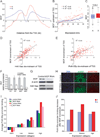Mammalian X upregulation is associated with enhanced transcription initiation, RNA half-life, and MOF-mediated H4K16 acetylation
- PMID: 23523075
- PMCID: PMC3662796
- DOI: 10.1016/j.devcel.2013.01.028
Mammalian X upregulation is associated with enhanced transcription initiation, RNA half-life, and MOF-mediated H4K16 acetylation
Abstract
X upregulation in mammals increases levels of expressed X-linked transcripts to compensate for autosomal biallelic expression. Here, we present molecular mechanisms that enhance X expression at transcriptional and posttranscriptional levels. Active mouse X-linked promoters are enriched in the initiation form of RNA polymerase II (PolII-S5p) and in specific histone marks, including histone H4 acetylated at lysine 16 (H4K16ac) and histone variant H2AZ. The H4K16 acetyltransferase males absent on the first (MOF), known to mediate the Drosophila X upregulation, is also enriched on the mammalian X. Depletion of MOF or male-specific lethal 1 (MSL1) in mouse ES cells causes a specific decrease in PolII-S5p and in expression of a subset of X-linked genes. Analyses of RNA half-life data sets show increased stability of mammalian X-linked transcripts. Both ancestral X-linked genes, defined as those conserved on chicken autosomes, and newly acquired X-linked genes are upregulated by similar mechanisms but to a different extent, suggesting that subsets of genes are distinctly regulated depending on their evolutionary history.
Copyright © 2013 Elsevier Inc. All rights reserved.
Figures







Comment in
-
Gene expression: Extra X expression.Nat Rev Genet. 2013 May;14(5):304. doi: 10.1038/nrg3479. Epub 2013 Apr 4. Nat Rev Genet. 2013. PMID: 23552217 No abstract available.
Similar articles
-
Intergenerationally Maintained Histone H4 Lysine 16 Acetylation Is Instructive for Future Gene Activation.Cell. 2020 Jul 9;182(1):127-144.e23. doi: 10.1016/j.cell.2020.05.026. Epub 2020 Jun 4. Cell. 2020. PMID: 32502394
-
Sex-biased transcription enhancement by a 5' tethered Gal4-MOF histone acetyltransferase fusion protein in Drosophila.BMC Mol Biol. 2010 Nov 9;11:80. doi: 10.1186/1471-2199-11-80. BMC Mol Biol. 2010. PMID: 21062452 Free PMC article.
-
Genome-wide analysis reveals MOF as a key regulator of dosage compensation and gene expression in Drosophila.Cell. 2008 May 30;133(5):813-28. doi: 10.1016/j.cell.2008.04.036. Cell. 2008. PMID: 18510926
-
The Functional Analysis of Histone Acetyltransferase MOF in Tumorigenesis.Int J Mol Sci. 2016 Jan 14;17(1):99. doi: 10.3390/ijms17010099. Int J Mol Sci. 2016. PMID: 26784169 Free PMC article. Review.
-
The MSL complex: X chromosome and beyond.Curr Opin Genet Dev. 2010 Apr;20(2):171-8. doi: 10.1016/j.gde.2010.01.007. Epub 2010 Feb 16. Curr Opin Genet Dev. 2010. PMID: 20167472 Review.
Cited by
-
Induction and inhibition of Drosophila X chromosome gene expression are both impeded by the dosage compensation complex.G3 (Bethesda). 2022 Aug 25;12(9):jkac165. doi: 10.1093/g3journal/jkac165. G3 (Bethesda). 2022. PMID: 35792851 Free PMC article.
-
The onset of C. elegans dosage compensation is linked to the loss of developmental plasticity.Dev Biol. 2014 Jan 15;385(2):279-90. doi: 10.1016/j.ydbio.2013.11.001. Epub 2013 Nov 16. Dev Biol. 2014. PMID: 24252776 Free PMC article.
-
Evolution of Sex Chromosome Dosage Compensation in Animals: A Beautiful Theory, Undermined by Facts and Bedeviled by Details.Genome Biol Evol. 2017 Sep 1;9(9):2461-2476. doi: 10.1093/gbe/evx154. Genome Biol Evol. 2017. PMID: 28961969 Free PMC article. Review.
-
Bipartite structure of the inactive mouse X chromosome.Genome Biol. 2015 Aug 7;16(1):152. doi: 10.1186/s13059-015-0728-8. Genome Biol. 2015. PMID: 26248554 Free PMC article.
-
Genomes of Ellobius species provide insight into the evolutionary dynamics of mammalian sex chromosomes.Genome Res. 2016 Sep;26(9):1202-10. doi: 10.1101/gr.201665.115. Epub 2016 Aug 10. Genome Res. 2016. PMID: 27510564 Free PMC article.
References
-
- Adler DA, Rugarli EI, Lingenfelter PA, Tsuchiya K, Poslinski D, Liggitt HD, Chapman VM, Elliott RW, Ballabio A, Disteche CM. Evidence of evolutionary up-regulation of the single active X chromosome in mammals based on Clc4 expression levels in Mus spretus and Mus musculus. Proc Natl Acad Sci U S A. 1997;94:9244–9248. - PMC - PubMed
-
- Akhtar A, Becker PB. Activation of transcription through histone H4 acetylation by MOF, an acetyltransferase essential for dosage compensation in Drosophila. Mol Cell. 2000;5:367–375. - PubMed
Publication types
MeSH terms
Substances
Associated data
- Actions
Grants and funding
LinkOut - more resources
Full Text Sources
Other Literature Sources
Molecular Biology Databases

